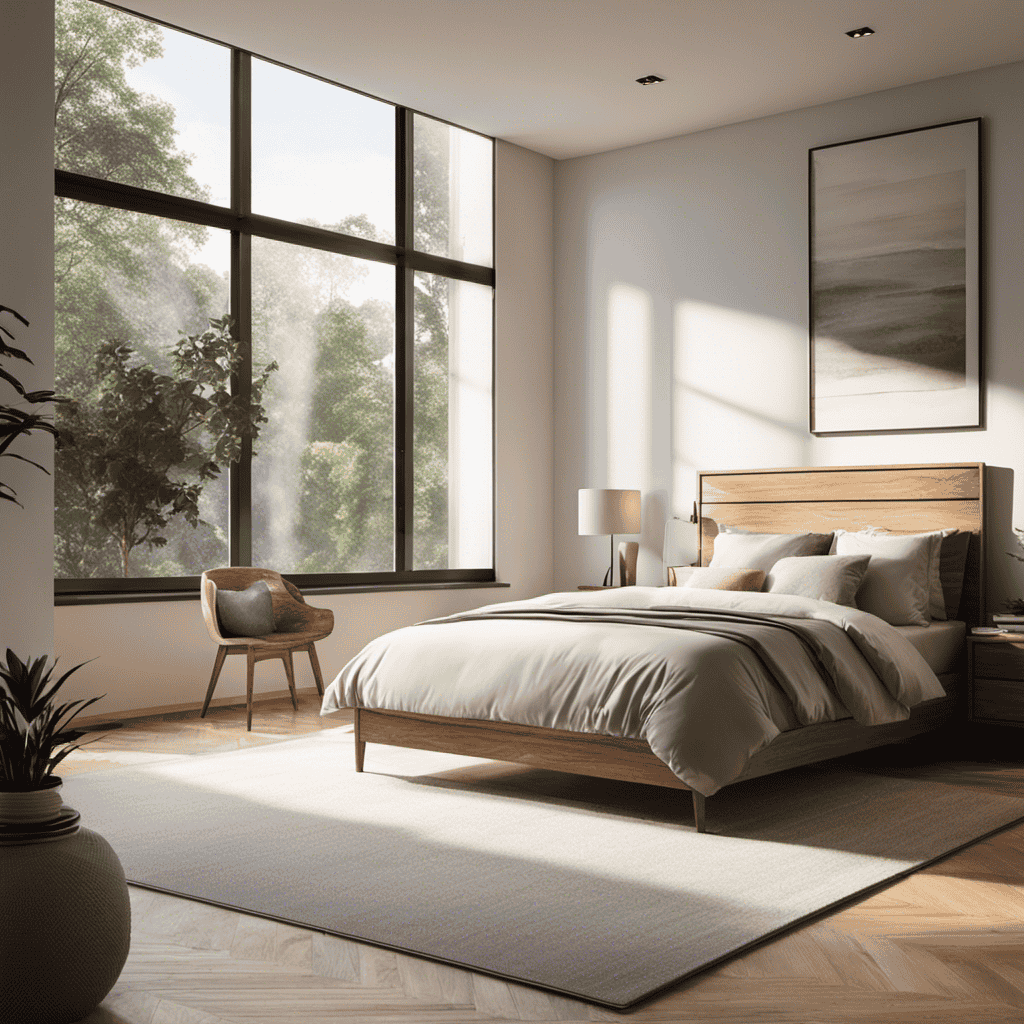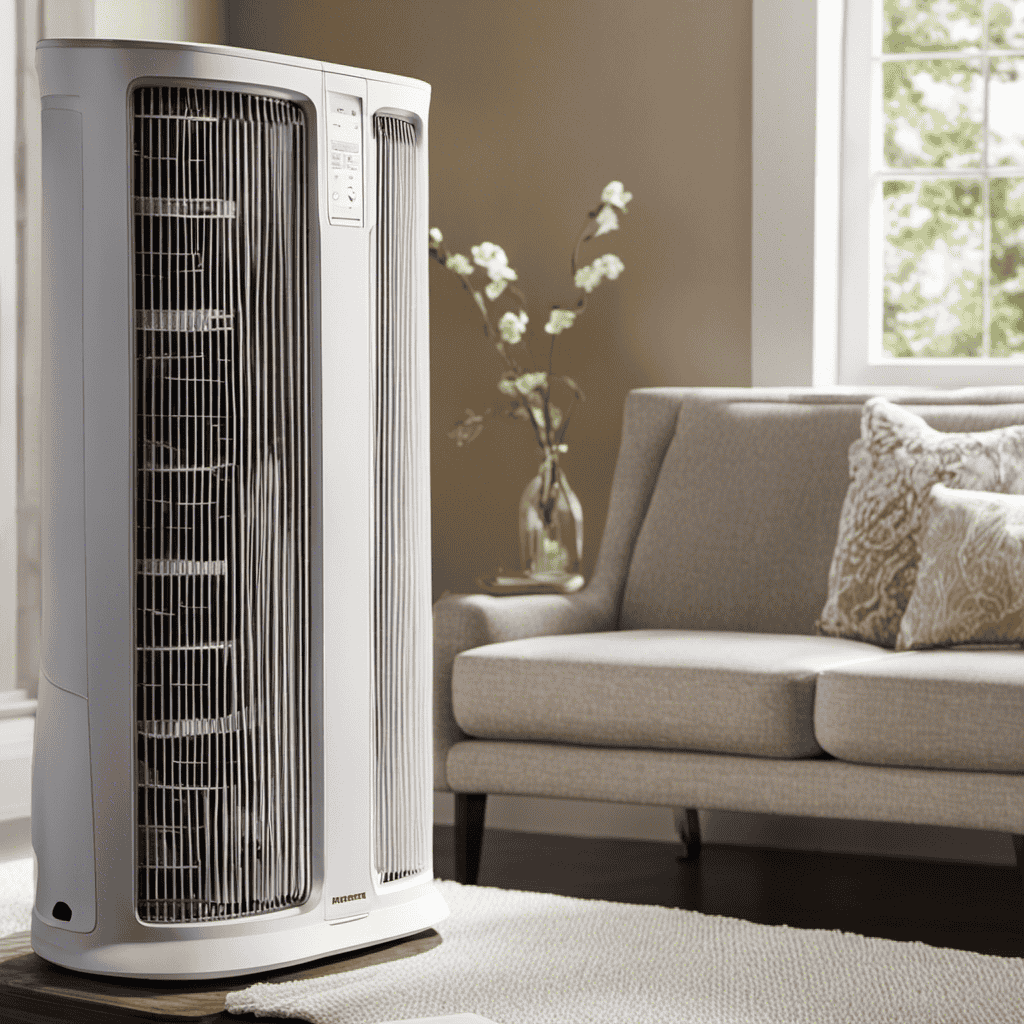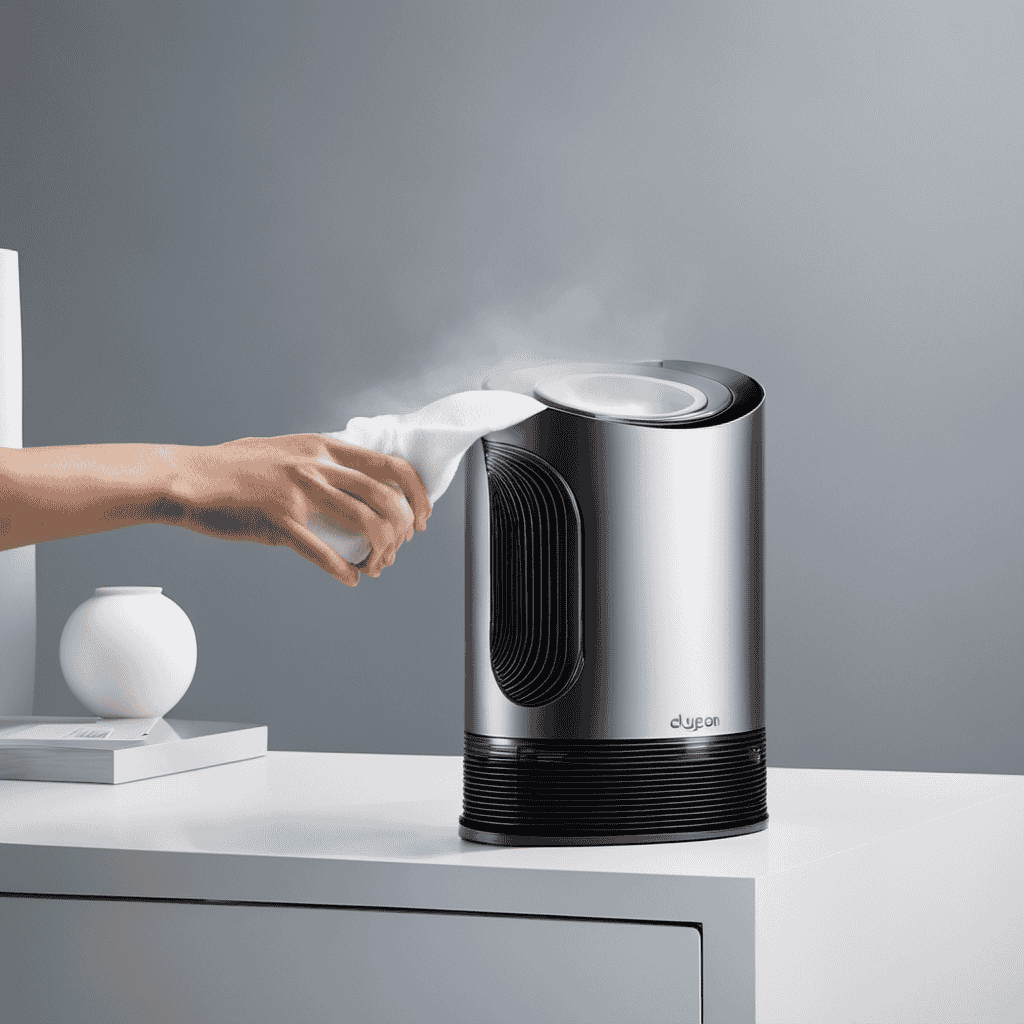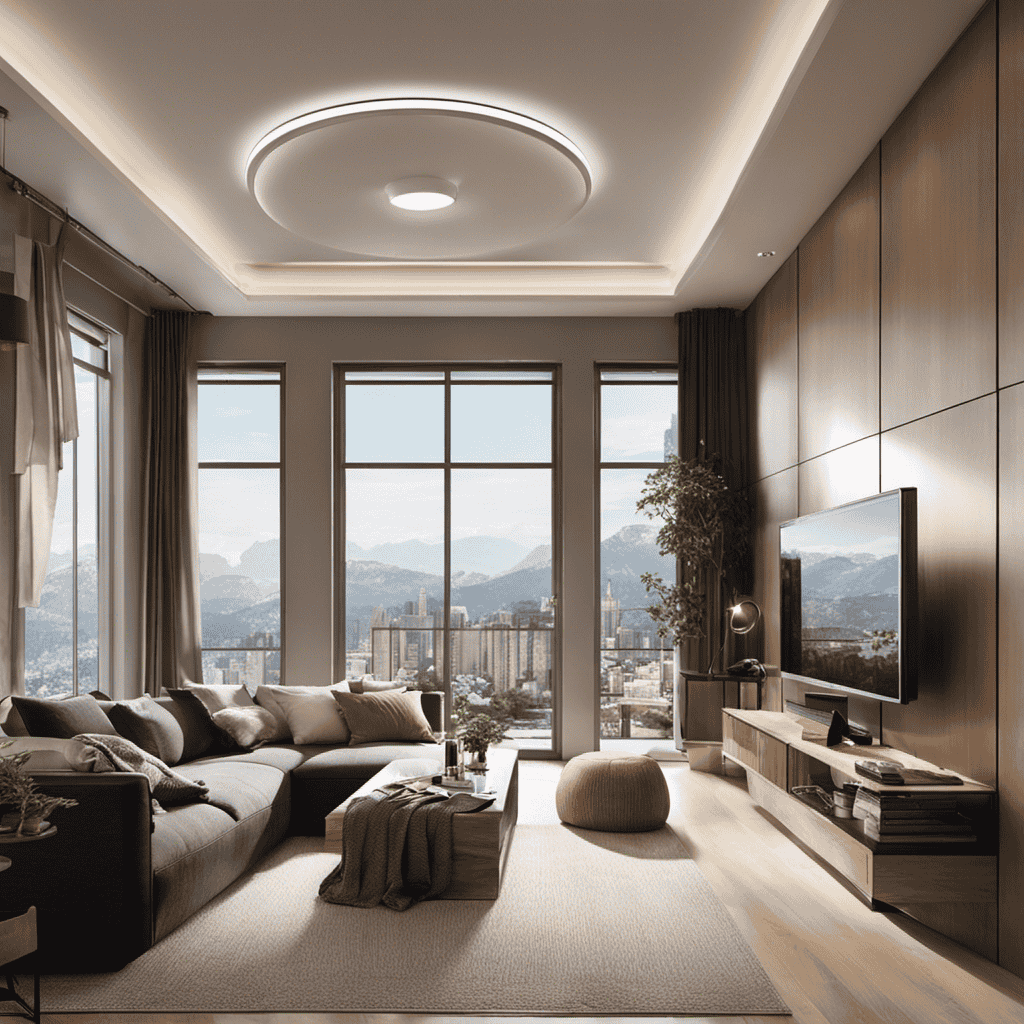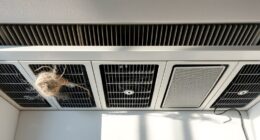Did you realize that the typical American spends approximately 90% of their time indoors? With such a significant amount of time spent indoors, it is essential to guarantee that the air we are breathing is clean and healthy. This is where air purifiers play a crucial role.
They are designed to remove pollutants and allergens from the air, creating a safer and more comfortable environment. But how long does it actually take for an air purifier to clean a room?
Let’s explore the factors that affect air purification time and discover some tips for optimal air purification.
Key Takeaways
- Placement of the air purifier affects its efficiency
- ACH (Air Changes Per Hour) is crucial for understanding air filtration effectiveness and selecting the right air purifier for room size
- Different filtration techniques, such as HEPA filters, activated carbon filters, UV-C light, and electrostatic precipitators, affect the air purifier’s effectiveness
- Regular maintenance and advancements in technology ensure the air purifier’s effectiveness in removing particles, odors, and harmful gases, thus maintaining clean and healthy indoor air quality.
Factors That Affect Air Purification Time
There are several factors that can affect how long it takes for an air purifier to clean a room.
One important factor is the placement of the air purifier. It is crucial to position the purifier in a location where it can effectively circulate air throughout the entire room. Placing it near a wall or furniture can obstruct the airflow and reduce the purifier’s efficiency.
Another factor to consider is the impact of air purifiers on energy consumption. Some models consume more energy than others, depending on their size, filtration system, and power settings. It is recommended to choose an energy-efficient model that meets your room size requirements to minimize energy consumption.
The Size of the Room Matters
The size of the room affects how quickly an air purifier can freshen the air. Larger rooms require more time for the air purifier to effectively clean the air, while smaller rooms can be purified more quickly. This is because the air purifier needs to cycle through a larger volume of air in larger rooms, which takes more time. To understand the impact of room size on air purification speed, let’s take a look at the following table:
| Room Size | Air Purification Speed |
|---|---|
| Small | Fast |
| Medium | Moderate |
| Large | Slow |
As you can see, the smaller the room, the faster the air purification speed. Understanding this relationship is crucial in determining how long it will take for an air purifier to clean a room. Now, let’s delve into the concept of air changes per hour (ACH) to further understand the purification process.
Understanding Air Changes Per Hour (ACH
Understanding ACH is essential in determining how quickly an air purifier can refresh the air in a room. ACH, or Air Changes Per Hour, refers to the number of times the air in a room is completely replaced by the air purifier within an hour.
It is a key factor in understanding air filtration and calculating the effectiveness of an air purifier. To calculate ACH, you need to know the volume of the room and the airflow rate of the air purifier. By dividing the airflow rate by the room volume, you can determine how many times the air will be exchanged in an hour.
A higher ACH indicates that the air purifier can clean the room more quickly and effectively. Understanding ACH is crucial in selecting the right air purifier for your room size and air quality needs.
How Air Purifiers Work
When it comes to understanding how air purifiers work, it is important to consider the air purification process, the filtration techniques used, and the effectiveness on air quality.
The air purification process typically involves the intake of air through a series of filters that are designed to capture and remove various pollutants and particles. These filters can range from pre-filters that capture larger particles to HEPA filters that can effectively remove microscopic particles, such as allergens and pollutants.
The effectiveness of an air purifier on air quality depends on factors such as the size of the room, the type of pollutants present, and the efficiency of the filtration system.
Air Purification Process
An air purifier typically takes about 30 minutes to clean a room. However, the efficiency of an air purifier can be affected by several factors.
First, the size of the room plays a crucial role. Larger rooms may require more time for the air purifier to effectively clean the air.
Additionally, the air purifier’s filtration system and fan speed also impact its efficiency. High-quality filters and stronger fans can clean the air more quickly.
Moreover, the level of air pollution in the room can affect the time it takes for the air purifier to complete its cleaning process. Rooms with higher levels of pollutants may take longer to purify.
It is important to note that the efficiency of an air purifier directly impacts respiratory health. A well-functioning air purifier can effectively remove allergens, pollutants, and irritants from the air, leading to improved respiratory health and reduced allergy symptoms.
Filtration Techniques Used
To effectively filter the air in your space, consider the different filtration techniques used. Here are four common filtration technologies used in air purifiers:
-
HEPA (High-Efficiency Particulate Air) Filters: These filters are highly effective at capturing particles as small as 0.3 microns, including pollen, dust mites, and pet dander.
-
Activated Carbon Filters: These filters use a process called adsorption to trap odors, chemicals, and volatile organic compounds (VOCs) from the air.
-
UV-C Light: This technology uses ultraviolet light to kill bacteria, viruses, and mold spores by damaging their DNA.
-
Electrostatic Precipitators: These filters use an electric charge to trap particles, removing them from the air.
To ensure the effectiveness of your air purifier, regular maintenance is crucial. This includes replacing filters as recommended by the manufacturer, cleaning the unit regularly, and keeping the surrounding area clean to prevent dust buildup.
Following these practices will help you maintain clean and healthy indoor air quality.
Effectiveness on Air Quality
Regular maintenance, including filter replacement and cleaning, is crucial for ensuring the effectiveness of air purifiers in improving indoor air quality.
With advancements in air purifier technology, it has become easier to maintain and monitor the performance of these devices. Many air purifiers now come with filter replacement indicators, which alert users when the filters need to be changed. Additionally, some models have self-cleaning mechanisms that prolong the lifespan of the filters.
These advancements not only make maintenance easier but also enhance the overall performance of the air purifiers. By regularly maintaining your air purifier, you can ensure that it continues to effectively remove pollutants from the air, such as dust, pollen, pet dander, and even harmful gases.
Different Types of Air Purifiers
There are various types of air purifiers available on the market. When it comes to choosing the right air purifier for your room, it’s important to understand the different filtration technologies and maintenance tips. Here are four types of air purifiers you can consider:
-
HEPA Filters: These filters are highly effective in removing particles as small as 0.3 microns, including dust, pollen, pet dander, and mold spores.
-
Activated Carbon Filters: These filters are great for removing odors, gases, and volatile organic compounds (VOCs) from the air.
-
UV-C Light Purifiers: These purifiers use ultraviolet (UV) light to kill bacteria, viruses, and other microorganisms that may be present in the air.
-
Ionic Air Purifiers: These purifiers use ions to charge particles in the air, making them stick to surfaces and reducing their presence in the air.
Maintenance tips for air purifiers include regularly replacing filters, cleaning the unit, and keeping the area around the purifier clean and free from dust. By following these tips, you can ensure that your air purifier functions optimally and effectively cleans the air in your room.
In the next section, we will discuss how to choose the right air purifier for your specific needs.
Choosing the Right Air Purifier for Your Room
When choosing the right air purifier for your room, there are several factors to consider. One important aspect is the air purifier features. Look for a purifier that has a high CADR (Clean Air Delivery Rate) to ensure efficient air cleaning. Additionally, consider the size of your room and choose an air purifier that is suitable for that space. Some air purifiers also come with advanced features such as smart sensors that monitor air quality and adjust the settings accordingly.
Another factor to consider when choosing an air purifier is noise reduction techniques. Some purifiers use quiet fans and advanced sound insulation materials to minimize noise levels. This is especially important if you plan to use the air purifier in your bedroom or any other area where noise can be disruptive.
Setting Up Your Air Purifier
Setting up your air purifier is a straightforward process that can be done in just a few simple steps. Here are the best placement strategies for air purifiers:
-
Choose the right location: Find a central area in the room where the air purifier can effectively circulate clean air. Avoid placing it near walls, furniture, or other obstructions that may hinder airflow.
-
Clear the surrounding area: Remove any objects or clutter that may block the airflow around the air purifier. This will ensure maximum efficiency and effectiveness.
-
Plug it in: Connect the air purifier to a power outlet. Make sure the cord is safely secured and not a tripping hazard.
-
Adjust the settings: Depending on your air purifier model, you may need to adjust the fan speed, timer, or other settings. Refer to the user manual for specific instructions.
Following these simple steps will help you set up your air purifier properly and ensure that it effectively improves the air quality in your room.
Importance of Regular Maintenance
Regular maintenance is crucial for keeping your air purifier running efficiently and ensuring that it continues to improve the quality of the air in your space. By regularly cleaning and replacing the filters, you can prevent dust, allergens, and other pollutants from accumulating and clogging the system. This helps maintain optimal airflow and ensures that the air purifier is able to effectively capture and remove contaminants from the air.
Additionally, the type of filter you use in your air purifier can have a significant impact on its performance. Different filters are designed to target specific pollutants, such as pollen, pet dander, or smoke. Choosing the right filter for your needs is essential for achieving the best results.
Now that we understand the importance of regular maintenance, let’s explore the role of filter quality in maximizing the effectiveness of your air purifier.
The Role of Filter Quality
When it comes to the role of filter quality in air purifiers, there are several key points to consider.
Firstly, the lifespan and effectiveness of the filter are crucial factors in determining the overall performance of the device. Different filters may have varying lifespans and levels of effectiveness in removing pollutants from the air.
Secondly, the type of filter used can have a significant impact on its ability to capture and eliminate specific airborne contaminants.
Lastly, understanding the impact of filter quality on air quality improvement is essential in order to make an informed decision when selecting an air purifier.
Filter Lifespan and Effectiveness
The filter’s lifespan and effectiveness can vary depending on factors such as air quality and usage patterns. To ensure optimal performance of an air purifier, it is essential to understand the impact of air pollution and the importance of timely filter replacement.
Here are four key factors to consider:
-
Air Quality: The level of pollutants in the surrounding environment directly affects the longevity of a filter. High levels of pollutants, such as dust, smoke, and pet dander, can clog the filter faster, reducing its lifespan.
-
Usage Patterns: The frequency and duration of usage play a significant role in filter lifespan. A purifier running constantly in a highly polluted environment will require more frequent filter replacements compared to one used occasionally in a cleaner environment.
-
Filter Type: Different filter types, such as HEPA or activated carbon filters, have varying lifespans. It is crucial to consult the manufacturer’s guidelines to determine the recommended replacement interval for each specific filter.
-
Maintenance: Proper maintenance, such as regular cleaning and filter inspection, can prolong the lifespan of a filter. Neglecting maintenance can lead to reduced effectiveness and the need for more frequent replacements.
Impact of Filter Type
If you want to optimize the performance of your air purifier, understanding the impact of filter type is essential. The filter efficiency plays a crucial role in determining how well your air purifier can clean the air in your home or office.
Different filter types have varying levels of efficiency in capturing airborne particles, such as dust, pollen, pet dander, and smoke. High-efficiency particulate air (HEPA) filters are considered the gold standard, as they can remove up to 99.97% of particles as small as 0.3 microns.
However, it’s important to note that the efficiency of the filter may decrease over time, especially if it becomes clogged with debris. To maintain optimal performance, regular filter replacement or cleaning is necessary.
It’s also recommended to follow the manufacturer’s maintenance tips to ensure the longevity and effectiveness of your air purifier.
Air Quality Improvement
In my previous subtopic, I discussed the impact of filter type on air purification. Now, let’s delve into ways to improve air quality beyond using an air purifier.
There are several natural air purification methods that can be employed to enhance ventilation and ensure cleaner air in a room:
-
Increase ventilation: Open windows and doors to allow fresh air to circulate and replace stagnant indoor air.
-
Use houseplants: Certain plants, like snake plants and peace lilies, can help remove toxins from the air and improve overall air quality.
-
Keep the space clean: Regularly dust, vacuum, and mop to reduce the presence of allergens and pollutants.
-
Avoid smoking indoors: Smoking releases harmful chemicals into the air, so it’s important to smoke outside or in designated areas.
How to Determine When the Air Is Clean
To figure out when the air is clean, you can use a separate air quality monitor. This device allows you to measure the level of pollutants in the air, helping you determine the cleanliness of your environment.
A good air quality monitor will detect a variety of pollutants such as particulate matter, volatile organic compounds (VOCs), and carbon dioxide levels. It will provide real-time data and display it on a screen, giving you accurate and up-to-date information about the air you breathe.
Common Mistakes to Avoid
One common mistake is not regularly maintaining your air quality monitor, which can lead to inaccurate readings. To ensure optimal air purification, it is important to avoid the following mistakes:
-
Neglecting filter replacement: Filters play a crucial role in trapping pollutants, but they can become clogged over time. Regularly replacing filters ensures efficient air purification.
-
Ignoring proper placement: Placing your air purifier in the wrong location can hinder its effectiveness. It is important to position it in an area that allows for proper airflow and coverage.
-
Underestimating room size: Air purifiers are designed to clean a specific square footage. Choosing the wrong size for your room can result in inadequate purification.
-
Not considering noise levels: Some air purifiers can be noisy, which can be disruptive in certain environments. It is important to consider noise levels when selecting an air purifier for optimal comfort.
Tips for Optimal Air Purification
Now that we have discussed common mistakes to avoid when using an air purifier, let’s move on to some tips for optimal air purification.
Proper maintenance is crucial to ensure that your air purifier is working effectively. Regularly cleaning or replacing the filters is essential to keep the unit in top condition. Additionally, it is important to follow the manufacturer’s instructions regarding filter replacement frequency.
Improving air circulation in the room can also enhance the performance of your air purifier. Make sure that the unit is placed in an area with good airflow and avoid blocking the air intake or output vents. Keeping doors and windows open occasionally can also help in refreshing the air in the room.
Can Multiple Air Purifiers Speed Up the Process
Using multiple air purifiers in a room can help expedite the purification process and improve overall air quality. Here are four reasons why using multiple air purifiers can lead to faster purification:
-
Increased coverage: By placing multiple air purifiers in different areas of a room, you can ensure that every corner is covered, maximizing the efficiency of the purification process.
-
Enhanced air circulation: Multiple air purifiers create better air circulation, allowing for faster removal of pollutants and allergens from the room.
-
Targeted filtration: Different air purifiers may have specific features or filters that target different types of pollutants. By using multiple purifiers, you can address a wider range of contaminants simultaneously.
-
Redundancy: Having multiple air purifiers provides a backup in case one unit malfunctions or requires maintenance, ensuring continuous purification.
Dealing With Persistent Odors and Allergens
When it comes to dealing with persistent odors and allergens, there are several key points to consider.
First, it is important to understand the different odor elimination techniques available, such as activated carbon filters or ozone generators.
Additionally, implementing allergen reduction methods like HEPA filters or regular cleaning can greatly improve indoor air quality.
Lastly, it is crucial to assess the long-term effectiveness of these measures, as some techniques may provide temporary relief but not address the root cause of the issue.
Odor Elimination Techniques
The air purifier can’t fully eliminate odors in a room. While it does a great job at reducing odors, there are some techniques you can use to enhance odor removal and maintain the effectiveness of your air purifier:
-
Regularly clean and replace the filters: Over time, filters can become clogged with particles, reducing their ability to capture odors. Cleaning or replacing the filters as recommended by the manufacturer is crucial for optimal performance.
-
Use activated carbon filters: These filters are specifically designed to target and absorb odors. They are effective in removing various smells, such as cooking odors, pet odors, and smoke.
-
Keep the room well-ventilated: Proper ventilation helps to circulate the air in the room, preventing odors from lingering. Open windows or use fans to improve air circulation.
-
Clean the air purifier itself: Regularly dusting and cleaning the exterior of the air purifier can prevent the buildup of dirt and debris, ensuring its optimal functionality.
Allergen Reduction Methods
To effectively reduce allergens in your space, it’s important to regularly clean and replace the filters in your air purifier. This ensures that the purifier is functioning at its optimal level and effectively capturing allergens in the air. There are several air purification techniques that can help control allergens in your environment. Here are a few examples:
| Technique | Description | Benefits |
|---|---|---|
| HEPA filters | High Efficiency Particulate Air (HEPA) filters are designed to capture particles as small as 0.3 microns, including pollen, dust mites, and pet dander. | Effectively removes allergens from the air. |
| UV-C light | Ultraviolet-C (UV-C) light is used to kill bacteria, viruses, and mold spores in the air. | Helps reduce the presence of allergens and improves indoor air quality. |
| Activated carbon filters | Activated carbon filters are effective in removing odors and volatile organic compounds (VOCs) from the air. | Helps eliminate unpleasant odors and reduces the presence of allergens. |
Long-Term Effectiveness Measures
Regularly maintaining your air purifier and utilizing effective allergen reduction methods can ensure long-term effectiveness in controlling allergens and improving indoor air quality. To maximize the lifespan of your air purifier and maintain its optimal performance, consider the following long-term maintenance measures:
-
Filter Replacement: Replace the filters according to the manufacturer’s recommendations to ensure efficient removal of allergens and pollutants from the air.
-
Regular Cleaning: Clean the exterior of the air purifier and remove any dust or debris that may accumulate on the surface.
-
Proper Placement: Position the air purifier in a location that allows for efficient air circulation and minimizes obstruction.
-
Routine Inspections: Regularly inspect the air purifier for any signs of damage or malfunction, and address any issues promptly to prevent further damage and maintain its effectiveness.
Improving Indoor Air Quality Beyond Air Purification
Did you know there are other ways to improve indoor air quality besides using an air purifier?
Indoor plants and ventilation systems are two effective methods that can help enhance the air we breathe indoors.
Indoor plants, such as ferns and spider plants, have been shown to filter out certain toxins and release oxygen into the air. These plants can also add a touch of greenery and beauty to any space.
Additionally, proper ventilation systems play a crucial role in maintaining good indoor air quality. Ventilation systems help to circulate fresh air, remove pollutants, and regulate humidity levels. This can prevent the build-up of harmful chemicals and allergens, creating a healthier environment for everyone.
Can Dyson Air Purifier Clean a Room Quickly?
Yes, the Dyson air purifier can clean a room quickly, as it is designed to cover a large area efficiently. The Dyson air purifier coverage area is exceptional, making it ideal for rapidly improving air quality in any room. Its powerful filtration system can effectively remove airborne pollutants in no time.
Frequently Asked Questions
Can Multiple Air Purifiers Speed up the Process of Cleaning a Room?
Yes, multiple air purifiers can speed up the process of cleaning a room. By placing them strategically, you can improve air circulation and filtration, helping to reduce airborne allergens, pollutants, and the spread of airborne illnesses. However, it’s important to consider that some air purifiers can be harmful to pets.
How Can I Deal With Persistent Odors and Allergens in My Room?
Dealing with persistent odors and allergens in my room can be challenging. However, using an air purifier equipped to handle pet dander and control cigarette smoke can greatly improve the air quality.
Are There Ways to Improve Indoor Air Quality Beyond Using an Air Purifier?
There are several ways to naturally improve indoor air quality, such as opening windows for proper ventilation and using natural air purifiers like plants. Maintaining good airflow is crucial for maintaining healthy indoor air quality.
How Do I Determine When the Air in My Room Is Considered Clean?
To determine when the air in my room is considered clean, I rely on measuring air quality using a device that detects particulate matter and pollutants. This helps me gauge the effectiveness of my air purifier and ensure optimal indoor air quality.
What Are Some Common Mistakes to Avoid When Using an Air Purifier?
When it comes to using an air purifier, there are some common mistakes to avoid. By following these tips, you can maximize the effectiveness of your purifier and ensure a clean and healthy environment.
Conclusion
In conclusion, the time it takes for an air purifier to clean a room can vary depending on several factors.
The size of the room and the air changes per hour (ACH) play a significant role in the purification process.
Understanding how air purifiers work and choosing the right type for your specific needs is essential.
Additionally, following tips for optimal air purification and considering multiple air purifiers can help speed up the process.
Ultimately, improving indoor air quality goes beyond just using air purifiers and requires a holistic approach.
